Northrop Grumman E-2 Hawkeye Videos
|
Loading...
|
|
Northrop Grumman E-2 Hawkeye
E-2 Hawkeye
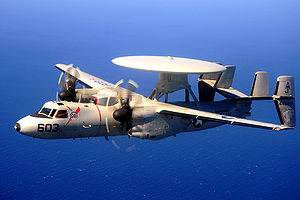
Picture - A US Navy E-2C Hawkeye
Role: Airborne Early Warning and Control
Manufacturer: Grumman
Northrop Grumman
First flight: 1960
Introduced: January 1964
Primary users: United States Navy
See operators
Unit cost: US$80 million
Variants: C-2 Greyhound
The Grumman E-2 Hawkeye is an American all-weather, aircraft carrier-capable tactical Airborne Early Warning (AEW) aircraft. This twin-turboprop airplane was designed and developed during the late 1950s and early 1960s by the Grumman Aircraft Company for the United States Navy as a replacement for the earlier E-1 Tracer, which was rapidly becoming obsolete. E-2 performance has been upgraded with the E-2B, and E-2C versions, where most of the changes were made to the radar and radio communications due to advances in electronic integrated circuits and other electronics. The fourth version of the Hawkeye is the E-2D, which first flew in 2007.
The E-2 also received the nickname "Super Fudd" because it replaced the E-1 Tracer "Willy Fudd". In recent decades, the E-2 has been commonly referred to as the "Hummer" because of the distinctive sounds of its turboprop engines, quite unlike that of turbojet and turbofan jet engines. The E-2 and its sister, the C-2 Greyhound, are currently the only propeller airplanes that operate from aircraft carriers. In addition to U.S. Navy service, smaller numbers of E-2s have been sold to the armed forces of Egypt, France, Israel, Japan, Singapore and Taiwan.
Design and development
Continual improvements in airborne radars up through 1956 led to the construction of AEW airplanes by several different countries and several different armed forces. The functions of command and control and sea & air surveillance were also added. The first carrier-based aircraft to perform these missions for the U.S. Navy and its allies was the Douglas AD Skyraider, which was replaced in US Navy service by the Grumman E-1 Tracer, which was a modified version of the S-2 Tracker twin-engined anti-submarine warfare aircraft, where the radar was carried in an aerofoil-shaped radome carried above the aircraft's fuselage. The E-1 was utilized by the U.S. Navy from 1958 to 1977.
In 1956, the U.S. Navy developed a requirement for an airborne early warning aircraft where its data could be integrated into the Naval Tactical Data System aboard the Navy's ships, with a design from Grumann being selected to meet this requirement in March 1957. Its design, initially designated W2F-1, but later redesignated the E-2A Hawkeye, was the first carrier plane that had been designed from its wheels up as an AEW and command and control airplane.
The first prototype, acting as an aerodynamic testbed only, flew on 21 October 1960, with the first fully equipped aircraft following on 19 April 1961. The E-2A entered U.S. Navy service on January 1964, April 1964 with VAW-11 at North Island NAS. The first deployment was aboard the USS Kitty Hawk (CVA-63) during 1965.
The E-2 is a high-wing airplane, with one turboprop engine in each wing, and tricycle landing gear. As with all carrier-borne airplanes, the E-2 is equipped with a tail hook for landings, and it is capable of using the aircraft carrier's catapults for take-off. A distinguishing feature of the Hawkeye is its 24-foot (7.3 m) diameter rotating dome that is mounted above its fuselage and wings. This carries the E-2's primary antennas for its long-range radars. No other carrier-borne aircraft possesses one of these, and among land-based aircraft, they are mostly seen atop the Boeing's E-3 Sentry, a larger AEW airplane operated by the U.S. Air Force and NATO in large numbers.
In U.S. service, the E-2 Hawkeye provides all-weather airborne early warning and command and control capabilities for all aircraft-carrier battle groups. In addition, its other purposes include sea and land surveillance, the control of the aircraft carrier's fighter planes for air defense, the control of strike aircraft on offensive missions, the control of search and rescue missions for naval aviators and sailors lost at sea, and for the relay of radio communications, air-to-air and ship-to-air.
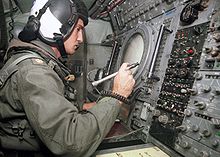
Picture - Hawkeye interior (Group 0 configuration)
The original E-2C, known as the Group 0, became operational in 1973, and it has undergone several upgrade programs during the decades since. The first of these was the E-2C Group I which replaced the E-2's older APS-125 radar and T56-A-425 turboprops with their improvements, their APS-139 radar systems and T56-A-427 turboprops. This version of the E-2 was followed within a few years by the more-improved Group II of the E-2C, which had the better APS-145 radar. The Group II has been incrementally upgraded with new navigational systems, better situational displays, and computerized electronics, culminating in the E-2C Hawkeye 2000 variant (sometimes called the Group III, although this term is no longer used as an official designation).
The E-2C and E-2D Hawkeyes use advanced electronic sensors combined with digital computerized signal processing especially its radars for early warning of enemy aircraft attacks and anti-ship missile attacks, and the control of the carrier's combat air patrol (CAP) fighters, and secondarily for surveillance of the surrounding sea and land for enemy warships and guided-missile launchers, and any other electronic surveillance missions as directed by the battle group's admiral in charge, or the captain of the aircraft carrier.
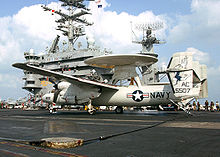
Picture - Ripples appear along the fuselage of a US Navy E-2C due to loads from landing on the USS Harry S. Truman (CVN-75)
The Hawkeye 2000 features the APS-145 radar with a new mission computer and CIC (Combat Information Center) workstations (Advanced Control Indicator Set or ACIS), and carries the U.S. Navy’s new CEC (cooperative engagement capability) data-link system. It is also fitted with a larger capacity vapor cycle avionics cooling system. A variant of the Group II with the upgrades to the mission computer and CIC workstations is referred to as the MCU/ACIS. All Group II aircraft have had their 1960s vintage computer-processors replaced by a mission computer with the same functionality but built using more modern computer technology. This is referred to as the GrIIM RePr (Group II Mission Computer Replacement Program, pronounced "grim reaper"). In 2007 and 2008 a hardware and software upgrade package is being added to Hawkeye 2000 aircraft that allows faster processing, double current trackfile capacity, and access to satellite information networks. Hawkeye 2000 cockpits are also being upgraded to include solid-state glass displays, upgraded weather detection systems, and GPS-approach capability. Tests of the refueling modifications are also being carried out.
E-2D Advanced Hawkeye
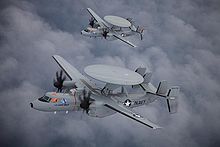
Picture - The first two prototype E-2Ds
Though once considered for replacement by the "Common Support Aircraft", this conception never went into production, and the Hawkeye will continue in its role as the Navy's primary AEW aircraft for years into the future in the E-2D version.
The latest version of the E-2, the E-2D Advanced Hawkeye, is currently under development and the first two aircraft, "Delta One" and "Delta Two" are in flight testing. The E-2D features an entirely new avionics suite, including the new APY-9 radar, radio suite, mission computer, integrated satellite communications capability, flight management system, improved turboprop engines, a new "glass cockpit", and the added capability for air-to-air refueling. The APY-9 radar features an Active Electronically Scanned Array, which adds electronic scanning to the mechanical rotation of the radar in its radome. The E-2D will include provisions for either one of the pilots to act as a Tactical 4th Operator, who will have access to the full range of the mission's acquired data. The E-2D's first flight occurred on 3 August 2007. The E-2D will undergo Initial Operational Test and Evaluation in 2011.
On May 8, 2009, an E-2D Advanced Hawkeye used "Cooperative Engagement Capability" to engage an overland cruise missile with a Standard Missile SM-6 fired from another platform in an integrated fire-control system test. Deliveries of initial production E-2Ds to Navy are to begin in 2010.
Operational history
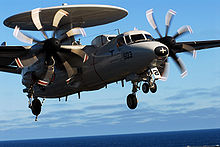
Picture - A US Navy E-2C of VAW-117 approaches to land on the flight deck of the USS John C. Stennis (CVN-74), clearly showing the new eight-bladed propellers being installed on all of the Navy's E-2Cs
Since entering combat in 1964 during the Vietnam War, the E-2 has served the US Navy around the world, acting as the electronic "eyes of the fleet". Hawkeyes from the air wing VAW-123 aboard the aircraft carrier USS America (CV-66) directed a group of F-14 Tomcat fighters flying the Combat Air Patrol during Operation El Dorado Canyon, the joint strike of two Carrier Battle Groups in the Mediterranean Sea against Libyan terrorist targets during 1986. More recently, E-2Cs provided the command and control for both aerial warfare and land-attack missions during the Persian Gulf War. Hawkeyes have supported the U.S. Coast Guard, the U.S. Customs Service, and American federal and state police forces during anti-drug operations.
The E-2 Hawkeye is a crucial component of all U.S. Navy carrier air wings, and each carrier is equipped with four Hawkeyes (five in some situations), allowing for continuous 24-hour-a-day operation of at least one Hawkeye, and allowing for one or two of them to be undergoing maintenance in the aircraft carrier's hangar deck at all times.
In the mid-1980s, several E-2Cs were bailed from the U.S. Navy to the U.S. Coast Guard and the U.S. Customs Service for counternarcotics (CN) and maritime interdiction operations (MIO). This also led to the Coast Guard building a small cadre of Naval Flight Officers (NFOs), starting with the recruitment and interservice transfer of former naval officers with E-2 flight experience and the flight training of other junior Coast Guard officers as NFOs. A fatal aircraft mishap on 24 August 1990 involving a U.S. Coast Guard E-2C at the former Naval Station Roosevelt Roads in Puerto Rico prompted the Coast Guard to discontinue flying E-2Cs and to return its borrowed E-2Cs to the Navy. The U.S Customs Service also returned its E-2Cs to the Navy and concentrated on the use of former U.S. Navy P-3 Orion aircraft in the CN role.
During Operation Enduring Freedom and Operation Iraqi Freedom all ten Regular Navy Hawkeye squadrons flew overland sorties. They provided battle management for attack of enemy ground targets, close-air-support coordination, combat search and rescue control, airspace management, as well as datalink and communication relay for both land and naval forces. During the aftermath of Hurricane Katrina, three Hawkeye squadrons (two Regular Navy and one Navy Reserve) were deployed in support of civilian relief efforts including Air Traffic Control responsibilities spanning three states, and the control of U.S. Army, U.S. Navy, U.S. Air Force, U.S. Marine Corps, U.S. Coast Guard, and Army National Guard and Air National Guard helicopter rescue units.
Hawkeye 2000s first deployed in 2003 aboard USS Nimitz (CVN-68) with VAW-117, the "Wallbangers", and CVW-11. U.S. Navy E-2C Hawkeyes have been upgraded with eight-bladed propellers as part of the NP2000 program; the first squadron to cruise with the new propellers was VAW-124 "Bear Aces". The latest version can track more than 2,000 targets simultaneously (while at the same time, detecting 20,000 simultaneously) to a range greater than 400 mi (640 km) and simultaneously guide 40-100 air to air intercepts or air to surface engagements.
VAW-120, the E-2C fleet replacement squadron began receiving E-2D Advanced Hawkeyes for operational use in July 2010. Initial operating capability for a E-2D fleet squadron ready for operational deployment has slipped to October 2014.
Other operators
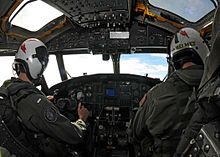
Picture - The cockpit of a E-2C Hawkeye of United States Navy Carrier Airborne Early Warning Squadron 115
E-2 Hawkeyes have been sold by the U.S. Federal Government under Foreign Military Sales (FMS) procedures to the armed forces of Egypt, France, Israel, Japan, Singapore and Taiwan (in alphabetical order). The French Navy has been the only operator of the E-2 Hawkeye from an aircraft carrier besides the U.S. Navy. The lone present French carrier, the Charles De Gaulle, currently carries three Hawkeyes on her combat patrols offshore.
The Israeli Air Force (IAF) operated four E-2s for its homeland AEW protection through 1994. The IAF was the first user of the E-2 to install air-to-air refueling equipment on E-2s. Three of the four Israeli-owned Hawkeyes were sold to Mexico in 2002 after they had been upgraded with new systems, and the remaining example was sent to be displayed in the Israeli Air Force Museum. In 2010, Singapore began retiring its E-2Cs as well. Both Israel and Singapore now employ the IAI Eitam, a Gulfstream G550-based platform utilizing Elta's EL/W-2085 sensor package (a newer derivative of the airborne Phalcon system) for their national AEW programmes.
In August 2009, the U.S. Navy and Northrop Grumman briefed the Indian Navy on the E-2D Advanced Hawkeye. This covered potential use of this platform to satisfy its current shore-based and future carrier-based Airborne Early Warning and Control (AEW&C) requirements. The Indian Navy reportedly expressed interest in acquiring up to six Hawkeyes.
Variants
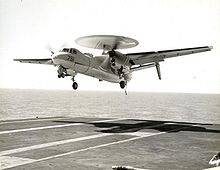
Picture - E-2A of VAW-11 landing in 1966 on the USS Coral Sea (CV-43)
W2F-1
Original designation of the Hawkeye, changed to E-2A in 1962.
E-2A
Initial production version, was W2F-1 before 1962. 59 built.
TE-2A
Two E-2As converted as crew trainers.
YC-2A
Two E-2As converted as prototypes of the C-2 Greyhound
E-2B
As E-2A but fitted with improved computing, enlarged outer fins. 52 converted from E-2A.
YE-2C
Two E-2As converted as E-2C prototypes.
E-2C
As the E-2B but with all new electronics, surveillance radar and search radar, 63 built. In "plus-models" the E-2C also has upgraded turboprop
engines.
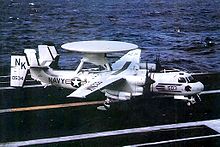
Picture - A VAW-113 E-2B after landing on the USS Coral Sea in 1979
E-2C Group 0
Initial production version of E-2C, fitted with AN/APS-120 or AN/APS-125 radar. Lengthened nose compared to earlier versions
E-2C Group I
New radar (AN/APS-139), plus ungraded mission computer and upgraded engines. 18 new build aircraft.
E-2C Group 2
AN/APS-145 radar, further improved electronics.
E-2C Hawkeye 2000
New mission computer, Cooperative Engagement Capability (CEC and additional satellite communications aerial. Originally designated Group 2+.
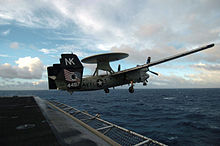
Picture - A U.S. Navy E-2C Hawkeye launches from USS John C. Stennis
E-2C Group 0
Initial production version of E-2C, fitted with AN/APS-120 or AN/APS-125 radar. Lengthened nose compared to earlier versions
E-2C Group I
New radar (AN/APS-139), plus ungraded mission computer and upgraded engines. 18 new build aircraft.
E-2C Group 2
AN/APS-145 radar, further improved electronics.
E-2C Hawkeye 2000
New mission computer, Cooperative Engagement Capability (CEC and additional satellite communications aerial. Originally designated Group 2+.
E-2D
Currently undergoing flight testing. This version will feature an entirely new avionics suite, improved engines, a new "glass cockpit" and the
ability for air-to-air refueling.
E-2T
E-2C variant for Republic of China (Taiwan), with parts taken from retired E-2Bs (USN BuNos 151709, 151710, 151724, 152479) in order to please objections
from the People's Republic of China and to make it appear as a sale of four rebuilt E-2As or E-2Bs. However, these aircraft have the same level of electronics
as the E-2C Group II Hawkeyes with their APS-145 radars.
Operators
Egypt
Egyptian Air Force has six E-2s, which were to be converted E-2 Hawkeye 2000 standard by the end of 2008.
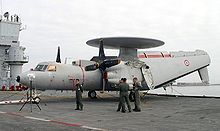
Picture - French Navy Hawkeye aboard the French aircraft carrier Charles De Gaulle.
France
French Naval Aviation fleet has three E-2 2000s, and is seeking a fourth.
Israel
Israeli Air Force operated four Hawkeyes through 1999.
192 Squadron IDFAF
Japan
Japan Air Self-Defense Force
601 Hikotai JASDF operates 13 E-2C Hawkeyes.
Mexico
Mexican Navy has three E-2C which were purchased from Israel.
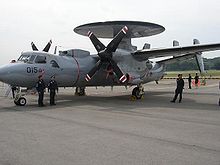
Picture - An E-2C Hawkeye of 111SQN Republic of Singapore Air Force.
Singapore
Republic of Singapore Air Force
111 Squadron operates four E-2C. They are currently in the process of being phased out with the newer Gulfstream G550 AEW as their replacement.
Republic of China (Taiwan)
Republic of China Air Force has four E-2Ts and two E-2C Hawkeye 2000. The four E-2Ts had been approved to be upgraded to Hawkeye 2000 configuration.
2nd Early Warning Squadron ROCAF
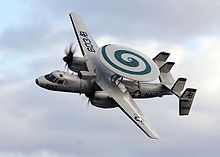
Picture - An E-2C Hawkeye, attached to the Screwtops of Carrier Airborne Early Warning Squadron VAW-123, performs a fly-by.
United States
United States Navy
VAW-77 Night Wolves (Navy Reserve Force Squadron)
VAW-78 Fighting Escargot (Navy Reserve Force Squadron; De-Commissioned)
VAW-88 Cottonpickers (Navy Reserve Force Squadron; defunct)
VAW-110 Firebirds (Fleet Replacement Squadron - Pacific Fleet FRS; De-Commissioned)
VAW-111 Graybirds (De-Commissioned)
VAW-112 Golden Hawks
VAW-113 Black Eagles
VAW-114 Hormel Hawgs (De-Commissioned, April, 1995 NAS Miramar)
VAW-115 Liberty Bells
VAW-116 Sun Kings
VAW-117 Wallbangers
VAW-120 Greyhawks (Fleet Replacement Squadron - originally Atlantic Fleet FRS, now single-site FRS for entire E-2 community)
VAW-121 Bluetails
VAW-122 Steeljaws (De-Commissioned)
VAW-123 Screwtops
VAW-124 Bear Aces
VAW-125 Tigertails
VAW-126 Seahawks
VAW-127 Seabats (De-Commissioned)
VX-20 Force Aircraft Test
U.S. Coast Guard
CGAW-1 (De-Commissioned)
Aircraft on display
E-2B, BuNo 150540, National Museum of Naval Aviation, NAS Pensacola, Florida
E-2B, BuNo 152476, Patuxent River Naval Air Museum, NAS Patuxent River, Maryland
E-2B, BuNo 152484, Air Victory Museum, Medford, New Jersey
E-2B, BuNo ______, NAS Norfolk Air Park (adjacent Gate 4), Naval Station Norfolk/Chambers Field (former NAS Norfolk), Virginia
E-2C, BuNo ______, on base memorial display (aircraft no longer air-worthy), NAS Point Mugu, California
E-2C, Israeli Air Force Museum, Hatzerim Air Base, Israel
Specifications (E-2C)
Data from US Navy fact file
General characteristics
Crew: Five: two pilots, combat information center officer, the air control officer, and the radar operator
Length: 57 ft 7 in (17.56 m)
Wingspan: 80 ft 7 in (24.58 m)
Height: 18 ft 3 in (5.6 m)
Wing area: 700 ft² (65 m²)
Empty weight: 37,678 lb (18,090 kg)
Loaded weight: 40,200 lb (18,090 kg)
Max takeoff weight: 53,000 lb (23,850 kg)
Powerplant: 2x— Allison T56-A-425 or -427 turboprop, 5,100 shp (-427) (3,800 kW) each
Performance
Maximum speed: 300+ knots (375 mph, 552 km/h)
Ferry range: 1,525 nmi (2,824 km)
Service ceiling: 30,000 ft (9,100 m)
Rate of climb: 2,515 ft/min (13 m/s)
Wing loading: 72.7 lb/ft² (355 kg/m²)
Power/mass: 0.19 hp/lb (0.32 kW/kg)
Related development
E-1 Tracer
C-2 Greyhound
Comparable aircraft
Fairey Gannet
Yakovlev Yak-44
E-3 Sentry
KJ-200
Airawat
Bibliography
Donald, David, ed. "E-2 Hawkeye". Warplanes of the Fleet. AIRtime, 2004. ISBN 1-880588-81-1.
Godfrey, David W. H. "Hawkeye:A New Dimension in Tactical Warfare". Air International, January 1977, Vol 12 No 1. Bromley, UK:Fine Scroll. pp. 7-13, 42-44.
Jackson, Mark. Jane's All The World's Aircraft 2003-2004. Coulsdon, UK: Jane's Information Group, 2003. ISBN 0 7106 2537 5.
Neubeck, Ken. E-2 Hawkeye Walk Around. Squadron/Signal Publications, 2008. ISBN 0-89747-555-0.
Swanborough, Gordon and Peter M. Bowers. United States Navy Aircraft since 1911. London:Putnam, Second edition, 1976. ISBN 0 370 10054 9.
Taylor, John W. R. Jane's All The World's Aircraft 1976-77. London:Jane's Yearbooks, 1976. ISBN 0 354 00538 3.
Winchester, Jim. "E-2 Hawkeye Developments". Air International, December 2005, Vol 69 No 6. Stamford, UK:Key Publishing. pp. 46-49.
Winchester, Jim, ed. Military Aircraft of the Cold War (The Aviation Factfile). London: Grange Books plc, 2006. ISBN 1-84013-929-3.
Northrop Grumman E-2 Hawkeye Pictures and Northrop Grumman E-2 Hawkeye for Sale.
Living Warbirds: The best warbirds DVD series.
Source: WikiPedia